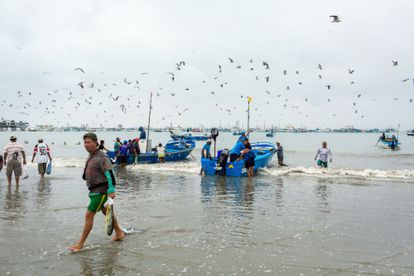
Violence continues to hit Ecuador hard. On Sunday, July 23, the mayor of Manta was assassinated. The city is one of the Ecuador’s main ports and is located about 400 kilometers (248 miles) from the capital Quito. Agustín Intriago, 38 years old, was shot while on a tour of sewage works. He was shot six times, mostly in the chest. The attack also left four people injured and one young woman dead — Ariana Chancay, a sportswoman, had approached the mayor to ask for help to buy uniforms for the neighborhood’s women’s soccer team.
Mayor Intriago was an extremely popular figure. This was his second term in office, which he won in the February elections with 61% of the vote. A few hours after the crime, the police had managed to apprehend a person in connection with the mayor’s murder and are continuing their investigation. The news shocked the country, which is currently extremely tense due to an increase in crimes such as robberies, kidnappings, extortions, and violent deaths. All this in the midst of an atypical electoral campaign.
The location where the mayor was killed is no less important. Manta is a city of just over 250,000 inhabitants in the province of Manabí. It is an open port on the deep Pacific Ocean and one of the gateways for drugs transiting from Colombia to other countries. Until 2009 it served as an enclave for a U.S. military base, which carried out aerial and maritime monitoring, but when former president Rafael Correa came to power, he amended Ecuador’s Constitution to prohibit foreign military bases in the country and the agreement was dissolved.
“Manta is an important area for the transfer of drugs abroad,” explains security analyst Mario Pazmiño. “It always has been.” In the late 1990s, the entire coastline of Manabí was used for human trafficking, with migrants hiding in the engines of fishing boats or speedboats heading to Colombia or Central America in an attempt to reach the United States. When migrants stopped traveling en masse, the entire structure created for human trafficking was switched to export cocaine.
A few years later, in 2012, the first evidence of Ecuador’s ties to the Mexican Sinaloa cartel was detected when the former governor of Manabí, Cesar Fernandez, was found with 115 kilos (253 pounds) of cocaine that was to be sent to Mexico under the criminal group’s brand. The authorities have information on at least two other cartels operating in Ecuador, the Jalisco New Generation and the Albanian mafia.
Since the pandemic, the backlog of drugs that could not be shipped has led to a turf war between various local criminal gangs that serve in the logistical operations of the Sinaloa and Jalisco New Generation cartels. At the moment “there is a surge of 700 tons of cocaine entering the country, and one of the ports through which most of the drugs leave is Manta,” says Pazmiño.
The crime against the mayor of Manta occurred in a particularly violent weekend in Ecuador. A few hours before Intriago’s murder, the government had raised an alert in all the country’s prisons for possible riots. It all started on Saturday afternoon, when bomb detonations and bullets being fired were heard at the Penitenciaría del Litoral prison in Guayaquil.
The information issued by the Service for the Attention of Persons Deprived of Liberty (SNAI) prison service was scarce, and they limited themselves to reporting that they still “maintained control of the penitentiary,” but the almost 24 hours of shootings, the column of smoke coming out of the prison, and the videos of headless and incinerated bodies told a different story. After numerous requests for information, the SNAI reported in a document on Sunday afternoon that six prisoners had died and 11 were wounded. It also stated that SNAI prison security agents “are being held by groups of criminal organizations,” in four prisons in the country, without further details. They have only reported that they are “in good condition” and that prisoners in 10 other prisons are on a hunger strike.
Sign up for our weekly newsletter to get more English-language news coverage from EL PAÍS USA Edition
This post was originally published on this site be sure to check out more of their content.






